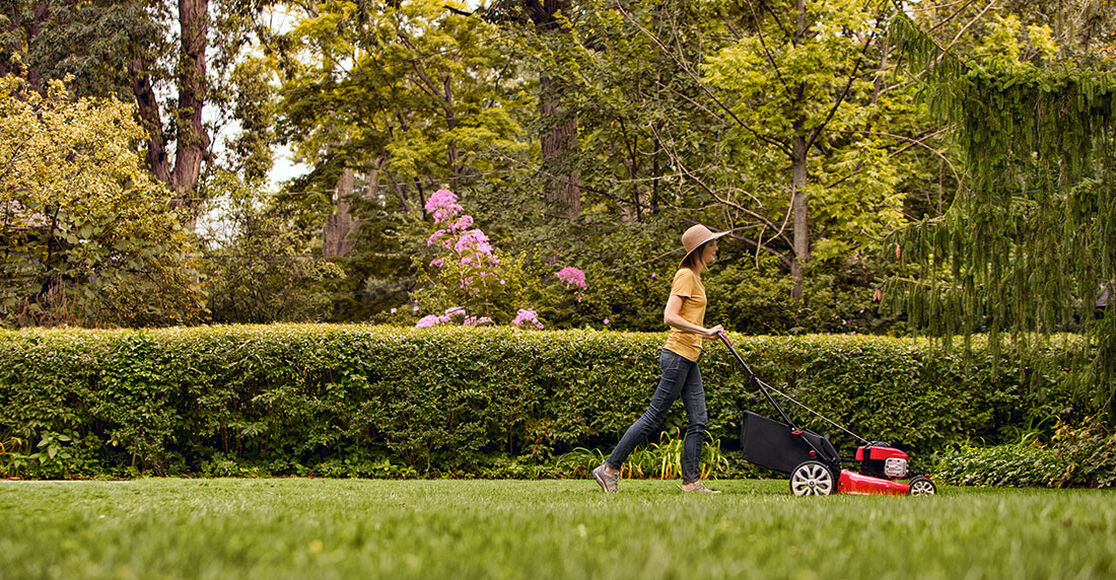Your outdoors to-do list is often full of a variety of chores that keep your yard tidy and in a healthy state. While some projects like installing a new garden bed or staining the deck may be one-off, others like mowing the lawn are ongoing tasks that can't be ignored.
Mowing the lawn should be done routinely, but sometimes that is easier said than done when trying to find the time to do so as it can easily fill an afternoon's agenda, making it difficult to complete other items on your list. But, with just a few adjustments to your current mowing routine, you can get to other projects and admire all your hard work sooner than usual.
Follow these mowing efficiency tips to help you reduce on time and be more productive in the yard.
Preparation
It may seem counterproductive, but taking a few minutes to ensure your mower is fueled and ready to go will save you time in the long run. Needing to refuel at any point once you've started to mow is a loss of time because it's unsafe to refuel a hot engine.
Also, if you've yet to sharpen your mower blades this season, do so before getting started. A sharp mower blade provides a clean, even cut and will prevent your mower from ripping grass from the roots, which can make entire areas of your lawn more susceptible to disease and damage. Time spent sharpening mower blades will help prevent and save time on creating potential lawn repairs down the road. Keep in mind though, mower blades should be replaced after they've been sharpened several times; they are relatively inexpensive and easy to change.
Timing
If you have some flexibility in your schedule, your lawn can really benefit from a well-timed cut. Mowing in mid-morning (between 8-10a.m.) is optimal; primarily because the early morning dew and irrigation has had time to dry, resulting in strong, perky blades of grass. Mowing too early on wet grass can leave ruts and cause grass to clump, settle and damage your lawn's roots. Mowing your lawn in mid-morning also gets you ahead of the beating sun, which can be tiring for you and your grass.
The next best time to mow is late afternoon, between 4-6 p.m. Cooling temperatures during this time of day will reduce stress on you and your grass. It also allows your grass a few hours of post-cut recovery time before nightfall. However, be mindful that mowing too close to nightfall (between 6-8 p.m.) will not give your grass enough time to recover, making your lawn more susceptible to fungus and turf disease.
Patterns
When you consider efficiency, the first thought that probably comes to mind is speed. Depending on the size and shape of your lawn, you'll want to mow in either rows or circles to achieve the fastest cut. Mowing in rows is usually the quickest, most efficient way to cut your lawn. But also take the direction of your rows into consideration. For example, if your lawn is wider than it is long, you should mow in horizontal rows. Mowing the longest rows in your lawn reduces your total number of turns, which allows you to work more quickly overall.
As nice as it is to finish mowing as quickly as possible, it's also beneficial for your lawn to alternate your mowing pattern. If you constantly mow in the same direction, grass begins to bend, and soil compacts. This can lead to reduced air flow, which can kill grass.
To reduce stress on your lawn and some of the monotony of mowing, while also maintaining speed, try a circular pattern. The idea behind mowing in circles follows the same principle as working in rows - limiting the number of turns. Mowing in circles might seem tricky if you're not used to maintaining that pattern. The enhanced control of a zero-turn mower like the Mustang 54 XP Zero-Turn Rider can allow you to easily navigate uneven or oddly shaped areas in your lawn while maintaining your circular pattern.
Features
If your lawn has features that will be an obstacle to mowing in a uniform pattern, you can usually save time by getting those areas out of the way first. For example, if you have flowers beds or ornamental trees in the center of your lawn, mow around them before moving on to your chosen pattern. Other features that you may want to tackle first include walkways, landscaping rocks, buildings, gardens and statues.
Having a lawn mower that can maneuver around obstacles, and navigate hills and downgrades can also help improve efficiency when you're working against different lawn features. The self-propelled TB410 XP 4x4 mower features front-, rear-, and all-wheel drive allowing you to freely switch between drive systems based on the terrain you're faced with. Having such versatility alleviates maneuverability problems and improves overall efficiency.
